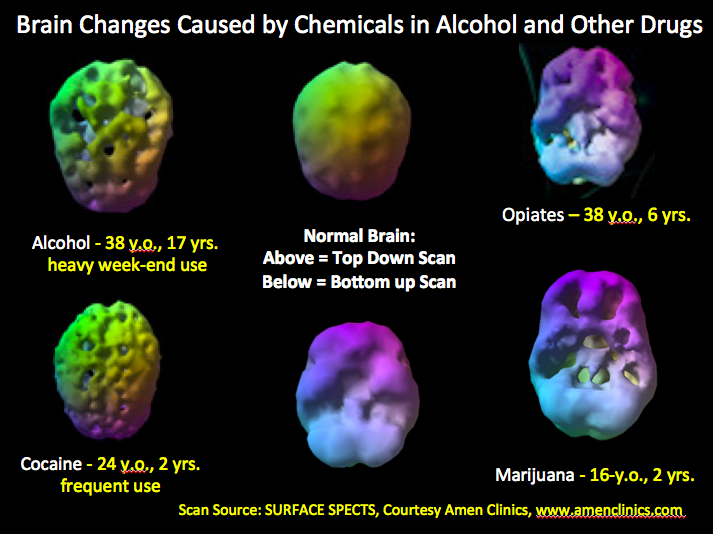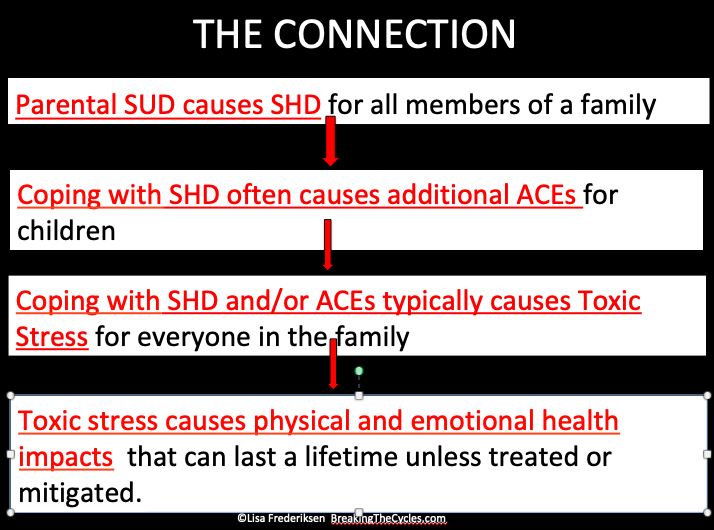
SPECT images show blood flow and brain metabolism. It is through the blood the brain gets the two things it needs to survive: oxygen and glucose. And it is through nutrient-rich sources of glucose the brain gets the vitamins, minerals, amino acids, and proteins it needs for healthy functioning.
What appear to be "holes" in the images above are not lost brain matter, rather they are areas of low blood flow/low brain metabolism, which is what changes brain health and functioning and therefore a person's thoughts, feelings, and behaviors. These chemical and structural brain changes are what make a person's brain more vulnerable to the risk factors for developing a severe substance use disorder. The brain can be repaired when substance abuse is stopped and other treatments are applied as needed.
SPECT is not diagnostic in and of itself. It is one part of a complete medical (clinical) evaluation. SPECT Scans: Courtesy Amen Clinics, www.amenclinics.com
Building Resilience Through Understanding Substance Use Disorders and Their Impacts on Others was the topic of a 3.5 hour presentation I delivered to three different organizations this spring; these organizations were also the program sponsors:
- San Joaquin County Office of Education and the San Joaquin County Children's Services Coordinating Commission (Stockton, CA, March 5, 2019)
- Fresno Council on Child Abuse Prevention (Fresno, CA, March 26, 2019)
- Kern County Network for Children (Bakersfield, CA, April 18, 2019).
Developing the Building Resilience Program
All three organizations have been working together for years and annually offer programs, such as this, to their Central Valley stakeholders. This year they wanted one that tied together child abuse and neglect and substance abuse, similar to how I'd explained it in my "Children of Addiction Awareness Week 2018" post. They applied for and were awarded a grant from the California Office of Child Abuse Prevention (OCAP) to cover my costs as well as purchase 800 copies of my book, Loved One In Treatment? Now What!, to give attendees.
Over the course of several months, I created this program, working closely with Jayme Stuart, Child & Family Services Coordinator Kern County Network for Children; Esther Franco, MBA, Executive Director, Fresno Council on Child Abuse Prevention; and Cathy Long, Coordinator, Children’s Services Coordinating Commission San Joaquin County. Attendees were given two comprehensive handouts I created: one covering key information and resources and the other providing conversation starters for ways to use the information presented in the work they do.
Attendee Affiliations
Approximately 800 people attended one of the three programs. Attendees represented early childhood education, foster care, juvenile and criminal justice, legal professions, CASA, probation, parents wanting custody after incarceration or treatment, school districts, child protective services, substance use disorder treatment centers, FASD, mental health, public health, sheriff and police, counselors and therapists....
It was incredibly rewarding to engage with so many people representing so many aspects of this broad - yet interconnected - field involving ACEs, resilience, neurobiology of SUD, secondhand drinking / secondhand drugging (SUD), toxic stress, treatment, recovery, brain development, and more.
Building Resilience Program Highlights
Topic Reach
The reach of substance use disorders in America is far more significant than people think. 21+ million Americans struggle with substance use disorders. Their substance use and addiction-related behaviors impact 100 million more Americans. These are the moms, dads, husbands, wives, children, brothers, sisters, grandchildren.... Together, these two groups represents more than one-third of the American population!
The following graphic illustrates the why and how of this connection and its impacts.
SUD = Substance Use Disorders; SHD = Secondhand Drinking/Secondhand Drugging - the negative impacts of a person's drinking or drug misuse behaviors on others; ACEs = Adverse Childhood Experiences

Presentation Sections
- Brain Basics: How the Brain Wires, Maps, and Develops -- helps explain how a person develops an SUD; experiences toxic stress related to coping with SUD-related behaviors; why a child's brain can be chemically and structurally changed by ACEs and SHD-related toxic stress; what it takes to change/re-wire a brain for better health and function.
- Neuroscience of Substance Use Disorders: How They Develop; How They Are Effectively Treated.
- Adverse Childhood Experiences & the CDC-Kaiser ACE Study -- a child exposed to parental substance use disorder (which is 1 of the ACEs measured in the Study) can develop up to 8 additional ACEs as a result of the family dysfunction caused by parental SUD and the SHD impacts on all family members.
- Secondhand Drinking | Secondhand Drugging -- the negative impacts of a person's drinking or drug misuse behaviors | affects 100 million Americans | causes toxic stress, which results in physical and emotional health impacts, such as: anxiety, depression, headaches, migraines, stomach ailments, sleep problems, some cancers, heart disease, skin problems, behavioral issues, ADHD misdiagnosis..., let alone the myriad of quality of life impacts that can have devastating consequences.
- Toxic Stress: the Consequence of Experiencing SHD and/or ACEs.
- Common Brain Healers to Build Resilience and Counter SUD, ACEs, SHD, and Toxic Stress.
Attendee Feedback
Part of the evaluation as to the success of this program will be use of the information presented. To that end, attendees were asked this question, “Based on what you heard today, please select which of the following ways you are willing to commit to implementing so that you can help make a difference for families who have experienced trauma.” The following shows one survey’s percentages of how attendees plan to use this information in their work.
- I will use the knowledge I gained to help children understand they are not the cause nor are they not lovable enough or good enough to ‘make’ a parent stop their SUD (78%)
- I will use the knowledge I gained to encourage people who are struggling with a SUD to view it as a treatable brain disease they developed and to seek the effective treatment they need. (74%)
- I will use the tools/skills/knowledge I gained to educate others in my community or sphere of influence about SUDs and SHD. (79%)
- I will use the tools/skills/knowledge I gained to educate others about SHD-and ACEs-related toxic stress. (81%)
- I will use the tools/skills/knowledge I gained to help children and adults become more resilient. (81%)
- I will use the information and healing tools presented to be more mindful of self-care. (86%)
Sampling of Attendee Comments:
- The training was very informational. I recommend the opportunity to all others in our community who works in the field.
- It was a fantastic presentation. I am a Psychologist, college professor, and a Licensed Drug and Alcohol Therapist. The way the presentation was put together and information given with resources to use was fantastic.
- Thanks to Lisa for being so real with her personal life experience - This made the topic all the more meaningful!
- Training should be provided to all community & business, and schools who work with children & families.
- Great training, videos, picture, graphs, & the personalization throughout the seminar.
- Amazing speaker
- Thank you - the training was amazing.
- The amount of time was appropriate. BUT I would have loved this to be a longer presentation.
- This was fantastic, I would love this on DVD.
- Well planned and delivered
- This was an excellent training. As someone married to a recovering addict, the presentation hit home. Lots of things I can do to help my family heal.
- Phenomenal job on providing so much useful information!
- I really enjoyed Lisa & her style & the information presented. Thank you!
- Thank you for this important information and many ideas that I can use.
- Enjoyed a wealth of information, so much in a short amount of time. Thank you.
- I really appreciate the resource flyer in folder.
- Would have liked it to be more interactive.
- Amazing conference, very insightful. Excellent speaker.
- I would have liked to spend more time understanding the brain. It was a lot of information to process.
- The Lisa Frederiksen presentation in March was incredible. I would appreciate her return so that I can recommend to those I now would benefit from it. I would consider it a life changer, I have told those around me, I walked away from the presentation 5 emotional pounds lighter! It definitely impacted how I approach children. Hugely appreciated and thank you for your efforts.
- Handouts were awesome.
- Best workshop I've ever been to.
Note: this post first appeared May 27, 2019, on BreakingTheCycles.com, https://www.breakingthecycles....r-impacts-on-others/.

Comments (0)